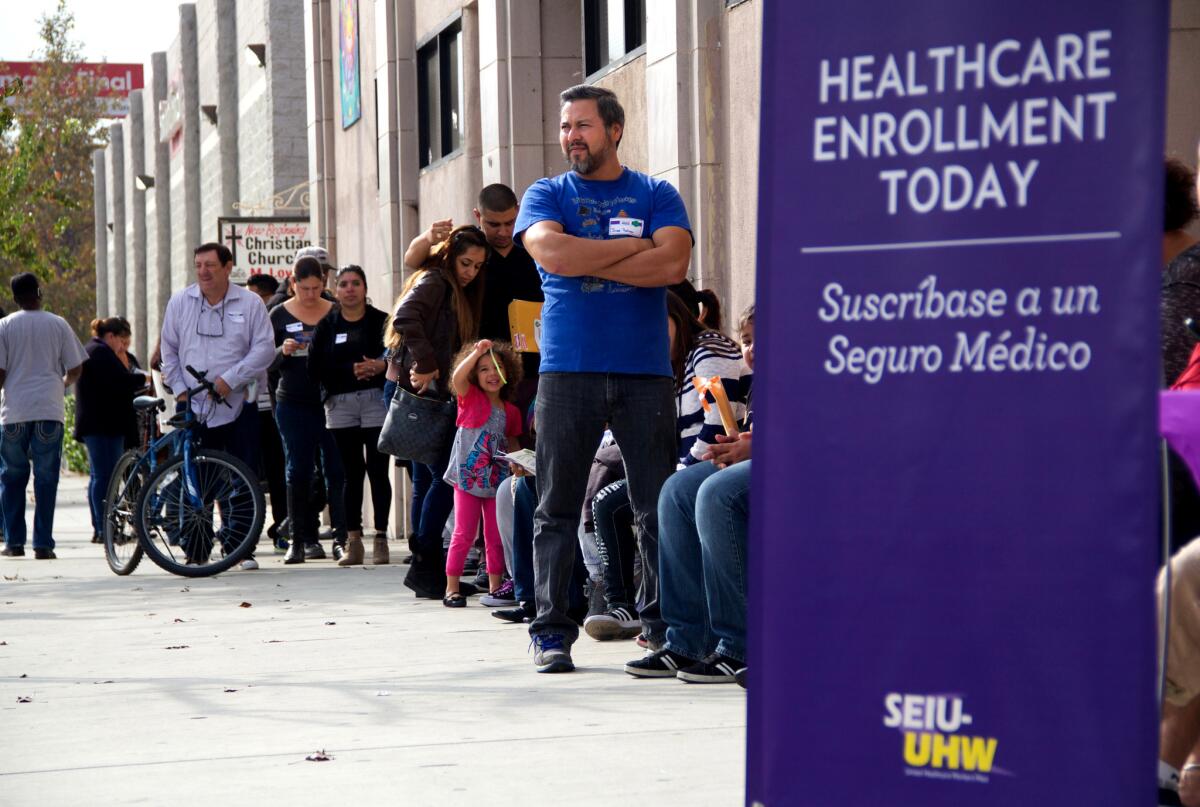Obamacare ‘sticker shock’? Still hasn’t happened.

People waiting in line in los Angeles to enroll in an ACA plan in November 2014.
- Share via
The depiction of the Affordable Care Act as a driver of huge increases in health insurance rates refuses to die, even though the record thus far shows that premium rate increases have shrunk since open enrollment for individual plans began in 2014.
The drumbeat is sounding again, based on early and incomplete filings by insurers. The drum majors typically are conservative news sources anxious to show that sticker shock hasn’t been eliminated, just deferred. But numerous general news agencies fomented the panic as well.
Many seized on a release a couple of weeks ago from the Department of Health and Human Services, which reported eye-popping double-digit rate increase requests. The agency, however, reported only requested increases larger than 10%; in any event, none has yet been reviewed by regulators, who in many states have the legal authority to pare them.
Those states, unfortunately, don’t include California, where voters last year rejected a measure to give the state insurance commissioner that power. On the plus side, the state’s exchange, Covered California, negotiates aggressively with health plans. Its average rate increase for 2015 was 4.2%; data for 2016 rates won’t be available for several weeks at the earliest.
A new data point arrived Thursday from the healthcare consultancy Avalere Health, which found that rate requests for 2016 in seven states and the District of Columbia are about 5.8% higher than 2015.
That’s higher than average nationwide rate increases in 2015, which came in at 2% to 5% for the silver range, according to federal officials. But it continues the pattern of post-ACA increases moderating from those in the individual market before the 2010 law kicked in: As the Commonwealth Fund reported in 2014, premiums in the individual market rose an average of 9.9% in 2008, 10.8% in 2009 and 11.7% in 2010.
The surveyed markets are Connecticut, Maryland, Michigan, Oregon, Vermont, Virginia, Washington, and the District of Columbia. That’s not a nationally representative sample, Dan Mendelson, Avalere’s CEO, told us, but it provides a sizable hint of where prices are heading.
“An increase of 5.8% is pretty good when it comes to medical price inflation,” he says. “The idea that premiums are basically under control is a reasonable one.”
Avalere properly qualifies its findings, which cover benchmark “silver” tier plans for a 50-year-old nonsmoker. At this stage, all projections, whether for high or moderate rate increases, are very preliminary.
They’re merely requests, subject to review and in many cases revision by state insurance regulators. Avalere’s calculations are unweighted, meaning that rate requests from a plan with, say, 200,000 enrollees are given the same significance in the average as a filing from a plan with 200 members.
Neither the Avalere or HHS statistics reflect that some of the larger requested hikes are coming from insurers that low-balled rates in the past, because they miscalculated their claims expectations or deliberately rolled out loss-leader pricing. They may be struggling to get back to the mean, while other insurers that priced rationally last year ask for more modest changes.
Perhaps most important, the raw numbers don’t reflect patterns of plan-switching, which for 2016 are as yet unknowable. This is the degree to which 2015 enrollees will choose a different plan for 2016, often for a lower price.
HHS estimated that about 70% of customers in the individual marketplace could have found a lower-priced plan in the same metal tier by actively shopping, but only 30% went back to their state or the federal exchange to do so. Shopping is crucial for many enrollees, Avalere’s Mendelson says, and the ACA exchanges make that relatively easy by allowing consumers to compare plans online by premium, deductible, and other features.
“People will have a lot of control over the premiums they accept and a lot of choices,” he says.
None of that will keep the anti-Obamacare camp from proclaiming sticker shock, despite a lack of evidence. House Ways and Means Committee Chairman Paul D. Ryan (R-Wis.), whose latest attack on the program we covered earlier, wasn’t above trying to make something out of nothing. “Premiums aren’t going down; they’re going up—way up,” he said Wednesday. Well, no, not yet they aren’t.
Keep up to date with the Economy Hub. Follow @hiltzikm on Twitter, see our Facebook page, or email michael.hiltzik@latimes.com.
More to Read
Inside the business of entertainment
The Wide Shot brings you news, analysis and insights on everything from streaming wars to production — and what it all means for the future.
You may occasionally receive promotional content from the Los Angeles Times.











